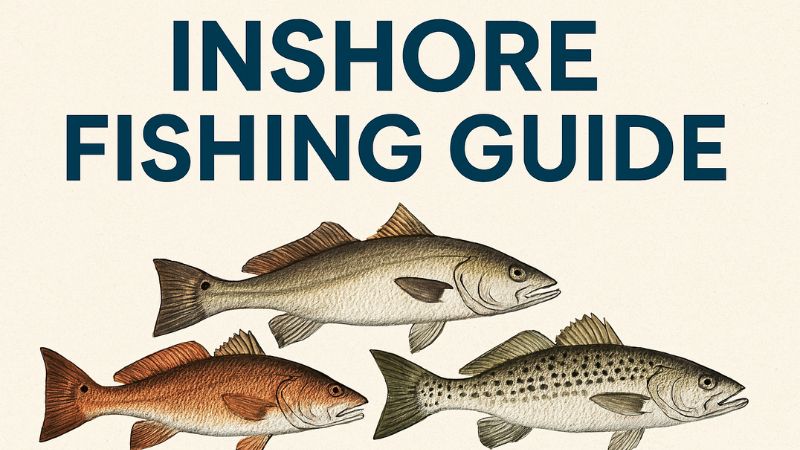Inshore Fishing Guide: Best Spots for Redfish, Snook & Trout
Inshore fishing is a style of fishing done in shallow, near‑shore waters — areas like bays, river mouths, mangroves, estuaries, and coastal flats. These waters often hold some of the most exciting game fish in North America: redfish, snook, and spotted seatrout (also called speckled trout).
Unlike deep‑sea fishing, which needs large boats and long travel, inshore fishing lets you stay close to land while still catching trophy‑size fish. It’s a good choice for beginners because the waters are calmer, but experts also enjoy the skill it takes to locate and catch fish in changing tides and conditions.
This guide will teach you:
- Where to find these fish
- How their habits change with the seasons
- The best bait and lures to use
- Tactics for success in different locations
- Safety, conservation, and planning tips
The goal is to make you more confident each time you step onto a boat, wade a flat, or cast from shore.
Redfish – Power and Patience on the Flats
Understanding the Species
Redfish are bronze‑colored, strong fighters with a signature black spot near the tail. They can grow to more than 40 inches and over 30 pounds. Smaller ones, called “slot fish,” are prized for eating. Larger ones, called “bull reds,” are often released after a quick photo.
Redfish like to feed on the bottom but will also chase baitfish or crabs near the surface in shallow water.
Prime Locations
- Florida: Tampa Bay, Indian River Lagoon, Mosquito Lagoon
- Louisiana: Marsh edges, oyster bars, backwater ponds
- Texas: Shallow grassy bays like Laguna Madre
- Carolinas: Tidal creeks and mud flats
Seasonal Patterns
- Spring: Warm afternoons bring fish to shallow grass flats. Look for “tailing” reds — their tails break the surface as they feed.
- Summer: Fish early or late when water is cooler. Shade from mangroves and docks can hold feeding fish.
- Fall: Redfish school in large numbers on open flats. Feeding is aggressive before winter.
- Winter: Cooler weather pushes fish into deeper holes, channels, and sunny mud flats that hold heat.
Baits and Lures
- Live bait: Shrimp, mullet chunks, small blue crabs
- Lures: Gold spoons, soft plastic paddle tails, weedless jerkbaits
- Tip: Make long casts to avoid spooking fish. Move quietly in shallow water.
Extra Tactics
- Match the lure size to local baitfish.
- Use natural colors in clear water and brighter colors in murky water.
- In windy conditions, try a heavier jig head for better casting.
Snook – Ambush Predators of the Mangroves
Understanding the Species
Snook are sleek, silver fish with a bold black line running down each side. Known for their strong runs and acrobatic jumps, they are one of the most sought‑after inshore fish in warm coastal waters.
They are structure‑oriented predators, meaning they hide near cover and strike quickly.
Hotspots
- Mangrove shorelines and roots
- Bridge and pier pilings
- Passes between barrier islands
- Shaded spots under docks
Seasonal Movements
- Spring to early summer: Many gather at inlets and passes for spawning.
- Summer: Stay near passes and beaches where bait is plentiful.
- Fall: Move back to bays, rivers, and mangroves as water cools.
- Winter: Hold in deeper backcountry creeks and canals with warmer water.
Baits and Lures
- Live bait: Pilchards, pinfish, large shrimp
- Artificial: Topwater plugs at dawn, soft jerkbaits near mangroves, swimbaits along bridge pilings
- Tip: Cast tight to structure. Snook often strike within seconds.
Extra Tactics
- Use a fluorocarbon leader to prevent break‑offs on rough surfaces.
- Fish tidal changes; moving water pushes bait to feeding spots.
- Pause your retrieve — snook often hit right after a stop.
Speckled Trout – Masters of the Grass Flats
Understanding the Species
Speckled trout are light‑colored with dark spots and can reach over 8 pounds in prime areas. They are aggressive feeders, often striking lures hard.
Where to Look
- Grass beds in 2–6 feet of water
- Sandy “potholes” within grass flats
- Channel edges and drop‑offs
- Oyster bars and nearby currents
Seasonal Behavior
- Spring: Move to shallow flats during baitfish runs.
- Summer: Feed early morning or at night to avoid heat.
- Fall: Feed heavily before winter, often in mixed schools with redfish.
- Winter: Stay in deeper holes, channels, or warm creek mouths.
Baits and Lures
- Live bait: Shrimp under popping corks, small mullet
- Lures: Soft plastics on jig heads, suspending twitchbaits, topwater plugs at sunrise
- Tip: Change retrieve speed until fish react.
Extra Tactics
- Drifting grass flats with a popping cork can cover more area.
- In colder months, slow your presentation.
- Use polarized glasses to spot sand patches and fish movement.
Top Inshore Regions for All Three Species
Florida
- Indian River Lagoon: Redfish and trout year‑round.
- Tampa Bay: Varied habitat for snook, redfish, and trout.
- Everglades backcountry: Remote creeks with all three species.
Gulf Coast
- Louisiana marshes: Known for large redfish and consistent trout.
- Texas bays: Trophy trout and strong redfish numbers.
Atlantic Coast
- South Carolina estuaries: Oyster bars and tidal creeks for all three fish.
- Georgia tidal rivers: Productive during seasonal runs.
Reading Conditions
Tides
Moving water is key. Plan trips around incoming or outgoing tides for active feeding.
Weather
- Overcast skies help fish feed longer.
- Sudden drops in temperature can slow activity.
- Light winds create ideal drifting conditions.
Water Temperature
Match lure speed to water temperature:
- Warm water: Faster retrieves
- Cold water: Slow, steady retrieves
Gear & Tackle
- Rods: 7–7’6″ medium‑light to medium power
- Reels: 2500–4000 size spinning or low‑profile baitcasting
- Line: 10–20 lb braid with 20–30 lb fluorocarbon leader
- Hooks: Circle hooks for live bait
- Lures: Mix of soft plastics, topwaters, spoons, and jerkbaits
Pro tip: Keep gear simple but well‑maintained. Saltwater can quickly damage reels and guides.
Guided Trips
Hiring a local captain can save time. They know tide charts, fish movements, and safe routes. Before booking:
- Ask about target species
- Discuss gear provided
- Check licenses and safety equipment
- Read recent reviews
Fishing Regulations & Conservation
Follow local slot and bag limits. Many anglers release large breeders to keep stocks healthy. Use barbless hooks if possible and revive fish before letting them go.
Safety & Planning
- Wear life vests when boating or kayaking.
- Check weather before trips.
- Carry sunscreen, polarized glasses, and water.
- Bring a small first‑aid kit.
- Tell someone your plan and return time.
Conclusion
Inshore fishing offers excitement, variety, and beauty right along the coast. By learning seasonal patterns, reading conditions, and using the right gear, you can improve your results. Whether chasing a tailing red, a crashing snook, or a striking trout, every trip can be a new adventure.

